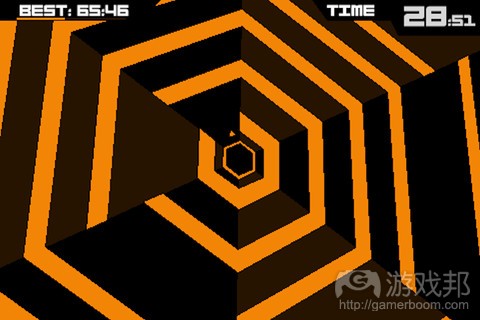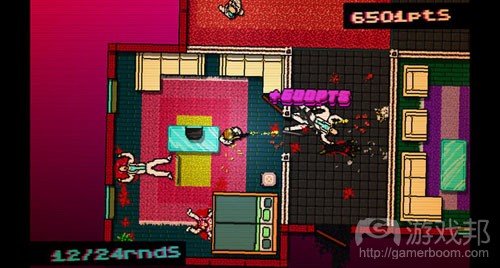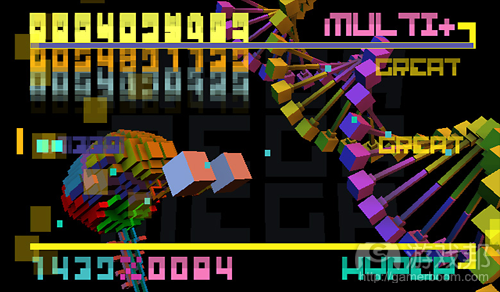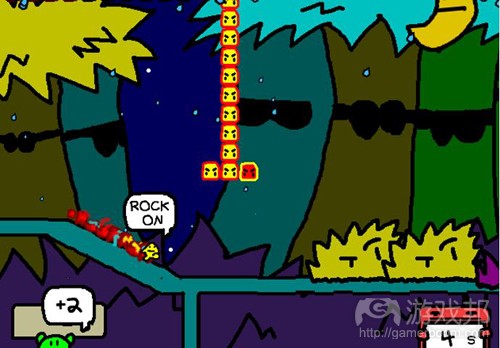举例阐述利用“心流状态”设计游戏的要点
作者:Mark Slabinski
“忘我,忘时。每一个动作和想法都自然而然地接在前一个后面,就像演奏爵士乐。你全身心投入,你的水平发挥到极致。”
——Mihaly Csikszentmihalyi
我一直在思考“心流状态”这个概念。它是游戏设计中一个模糊但美妙的概念。在“心流状态”的作用下,玩家完全可以轻松应对关卡的挑战,即使当玩家离开游戏,他的部分心思仍然停留在游戏上。也就是在这个时候,游戏设计打破了了屏幕和玩家之间的固有屏障。
流状态赋予游戏以忘时的魅力。一款能让玩家产生心流状态的游戏,可以让玩家沉迷好几年。如果说有什么东西能让玩家记住游戏、痴迷于游戏,那么它就是“心流状态”。一款能让玩家产生流状态的游戏,必定是在真正考虑了玩家的前提下设计出来的,并且这种考虑体现在设计的方方面面。没有任何多余的东西,一切都完美地融入游戏设计的框架中。有考虑心流状态的游戏和没有考虑心流状态的游戏,二者之间的区别也可能是一款赚不到钱的游戏和一款赚大钱的游戏之间的区别。
现在,有许多关于“心流状态”的研究,但主要集中于音乐和体育。然而,几乎所有的研究都专注于流状态本身,而不是引发流状态的办法。对于设计师来说,这是个难题,一旦解决将受益无穷。
毫无疑问,演讲和游戏理论已经无数次提到Csikszentmihalyi的关于流状态的10个要点,但我还是打算再提一次。一般来说,在描述游戏中的流状态时,只会用到3、4个要点,但我还是希望把他在TED演进上提到的这10个要点都列出来:
1、明确的目标,具有挑战性,但仍然可能达到。
2、精神高度集中。
3、活动本身就是内在奖励。
4、平静的感觉,忘我的状态。
5、忘时,时间错乱,太专注于此时此刻的活动,以致于忘记时间的流逝。
6、立即反馈。
7、知道任务是可以完成的;操作水平和挑战之间达到平衡。
8、感到处境和结果都在个人的掌控之中。
9、忘记生理上的需要。
10、完全专注于活动本身。
我们理解这些表明心流状态产生的元素,并不意味着我们知道如何引发流状态。这10个要点中有一半是关于如何把游戏做得更好,或设计游戏时应该专注于什么。明确的目标,以及操作水平与挑战之间的平衡?无论你设计什么,这两点都是必须的。但有些要点却比较模糊,比如,什么叫作“活动本身就是内在奖励”?忘我的状态又是什么?满足引发心流状态的所有这10个要素绝非易事,但我相信这绝对是天才的游戏设计师的目标。
就我个人而言,关于人类进入“心流状态”的表现,只有研究游戏中的心流状态最有趣。在音乐、运动、绘画等活动中的流状态都以人们确实进入心流状态的特点、生理效应和执行效应为中心,而不太考虑可能导致他们进入心流状态的因素。
另外值得一提的是,本文提到的引发“心流状态”的因素只针对游戏,不考虑其他媒体。一部好电影可以使观众达到痴迷忘我的境界,但看电影只是一种被动活动,所以不可能满足进入心流状态的所有要求。
所以,我们可以从分析的角度来看待心流状态。什么游戏能体现心流状态?哪些开发者掌握了进入心流状态的技术?这两个问题可不好回答,因为心流状态本身就没有精确的衡量标准。你可以观察到它,你可以知道机制什么时候起作用,你可以看出人们进入心流状态,但你不可能衡量心流状态的程度——也就是,要么进入心流状态,要么没有进入心流状态。
引发心流状态不是利用心理学技术开发致瘾机制。心流状态不是《魔兽世界》刺激人类的爬虫脑(游戏邦注:神经系统最原始的部分之一,它处理人类的情感,如欲求、动机、专注和渴望等),导致玩家坚持不懈玩游戏的方式。流状态并不使用华而不实的东西和肤浅的成就感来吸引玩家多花钱。流状态与游戏中的内在价值无关,玩家动机就是:为了玩游戏而玩游戏。
案例
虽然有上百款游戏和许多开发者可以与心流状态联系起来,但我个人认为,以下开发者以及他们的游戏特别能作为引发心流状态的范例。
Terry Cavanagh的《VVVVVV》、《Super Hexagon》:这位开发者曾经详细地表述了他制作游戏的过程。作为一个多产的独立开发者,他遵循“跟着乐趣走”的设计原则。他的游戏以极简风格为特点,从中我们可以看出如何在考虑流状态的情况下做出一款简单又有趣的游戏。
Cactus的《Hotline Miami》:很长时间没有出现像《Hotline Miami》这样的游戏了。在这款游戏中,你会一直失败,以致于你觉得自己越玩越蠢,当你终于开始好好计划如何通关时,你才能成功。《Hotline Miami》虽然变态又血腥,但却是一款好游戏。这款游戏的很多方面都做得不错,比如控制玩家杀掉敌人后的满足感,快速的游戏节奏。
Gaijin Games的《Bit.Trip.Beat》、《Bit.Trip.Runner》:这一系列的游戏以简单、几乎无节奏的玩法和简洁迷人的美术风格为特点。
Team Meat的《超级食肉男孩》、《以撒之困》:Edmund Mcmillen和Tommy Refenes与Terry Cavanagh一样,已经谈过游戏的制作过程和游戏的难度以及如何利用难度促进心流状态产生。《超级食肉男孩》是游戏设计的教科书式典范,虽然这款游戏难度极大,但它竭尽全力减轻玩家的挫败感。
Valve的《传送门2》、《半条命2》:如果不提Valve,那么我列的这个表就不能圆满了。这个游戏巨人非常舍得花时间不断重制关卡,他们总是确保把引发心流状态的元素设计好,避名让玩家感到无奈、无助、无聊。
Derek Yu和《洞穴探险》:在我看来,《洞穴探险》是有史以来最优秀的一款“残酷的”游戏。它的难度很大,但与我在本文中提到的其他游戏一样,它完成了“永远不让玩家觉得这是游戏的错”的壮举。在游戏中,玩家只觉得每一次死亡都是自己的误算和急躁造成的,所以即使死了20次,还是愿意重来。玩家在《洞穴探险》的一个关卡所做的风险计算不亚于玩《黑暗之魂》。
That Game Company(TGC)的《Flow》、《Flower》、《Journey》:考虑到这个公司确实有一款游戏也叫《Flow》,所以不提它就太可笑了。TGC的游戏总是能实现完美的平衡:玩家会迷上游戏,会收获不同程度的成就感。没有人能挑剔他们的美术设计、玩法、音乐或设计哲学。《Journey》无愧于游戏史上的艺术杰作。
Tom Sennet和Matt Thorson的《Runman: Race Around the World》:这款游戏充分体现了最怪异的组合如何引发流状态。《Runman》似乎是用微软绘图软件和上世纪20年代的爵士乐和蓝调拼凑成的游戏,但这些元素与游戏节奏完美融合,特别是在BOSS战中。只要实现平衡,即使是拼贴不相干的元素,也能很棒的游戏。
其实例子还有很多,所以我得向那些没有被点名的开发者们说声抱歉。《每日射击》、《Noitu Love 2》、《俄罗斯方块》、《吃豆人》、《植物大战僵尸》、《屋顶狂奔》、《几何战争》、《Smash Brothers》、《街头霸王2》、《DDR》和无数游戏都有资格上榜。我列举以上游戏的目的是为了说明心流状态的产生形式是多种多样的,并且游戏各不相同,几乎所有游戏都能从中借鉴一些可循环利用的元素。
借鉴明智的设计选择
这就到了本文的精华所在。以下是我在不同游戏中一次又一次见到的元素,也是我本人力图内化到自己的设计中的元素。同时,我也努力记住那些让我感到困扰的或破坏了心流状态的游戏,以免我自己犯下同样的错误。我还要提醒的一点是,以下建议并非对所有游戏都适用。因为这些只是我能想到的、我觉得特别的,我想设计的游戏类型。毕竟,不存在能让所有玩家都进入心流状态的游戏。
1、清楚,色彩丰富
上文提到的游戏有一个共同点:声音与画面的完美结合。这些游戏有直观的视觉设计,所以玩家不会产生太多理解上挫败感。
视觉简化也是促进心流状态产生的因素之一。大脑处理信息的能力有限,所以必须确保显示在屏幕上的信息,无论是HUD还是游戏中的对象,不会多到让玩家感到不知所措。特别是在策略游戏和RTS中,警示消息被大量的竞争信息淹没了,所以玩家有时会因此损失大量单位,这是特别令人恼火的事。
在《超级食肉男孩》和《洞穴探险》这类游戏中,游戏中的一切都是清楚易辨的,没有任何敌人或障碍会让玩家觉得:“我死了是因为没有看到这东西!”这些游戏让我们能够做准备,而当我们能为某些事物做准备时,我们就会觉得有控制感了。
2、音乐
虽然要不要使用音乐很大程度上取决于游戏,但有些游戏确实或多或少地从使用音乐中受益。《Hotline Miami》如果少了它令人震憾的音乐,肯定无聊透顶。《Runman》如果没有Blind Blake和Django Reinhardt的歌声,一定乐趣大失。显然,游戏中的音乐设计也是一种艺术,虽然未必导致心流状态,但仍然有必要巧妙地选择音乐。
记住,在音乐中进入一种恍惚迷幻般的状态是有可能发生的。忽略心流状态中音乐的作用,特别是心流状态的忘时和平静方面,是短见的表现。
3、上手易,精通难
我提到的游戏大多上手容易,但要精通还是比较困难的。事实,有些玩家甚至在第一次玩时就被打败了。理论上说,具有超人般反应力的玩家可以轻松通关《Super Hexagon》和《超级食肉男孩》;具有极端自控力的玩家可以一次性完成《洞穴探险》或《Bit.Trip.Runner》;具有非凡控制力的玩家可以把移动距离按象素来调整(控制力减轻挫败感)。
当然,以上说法几乎不可能成真,但重点是,许多游戏的根本机制是很容易上手,但要达到精通程度仍然很困难。人人都能入门,但成为专家还要费不少时间。竞技游戏因此处于一种非常尴尬的局面,因为玩家很难在这种游戏中产生心流状态,除非玩家的对手在水平上与他相当;这也就是为什么准确的匹配系统决定了一款在线多人游戏的成败。无论战斗引擎设计得多么好,只要玩家在排长队等来的比赛中被对手反复击杀却学不到任何东西,这种游戏就不可能有趣。
《矮人要塞》、《Paradox Games》和某些竞技游戏如《DOTA 2》和《Third Strike》等都存在这样的问题:想要玩得好,必须先掌握大量与游戏相关的知识和技能。虽然一旦玩家达到某个水平就能立即从游戏中得到满足感,但一般玩家要达到心流状态,仍然需要相当长的时间。经过一段时间后,心流状态应该会持续不断,直到游戏结束。
4、奖励和鼓励:萝卜比大棒好
上述提到的许多游戏只给玩家提供立即的、短期的目标,使挑战/奖励平均地分布在整个游戏过程中。在《Super Hexagon》中,能比上一次的最好成绩多坚持几秒钟本身就是一种成就。心流状态的关键组成部分是,让玩家始终相信自己有能力做某事。
以《街头霸王》为例,这款游戏的基础就是击溃对手的自信心和心流状态,从而迫使对手怀疑自己、产生压力。格斗游戏玩家经常提到,当他们被对手打得很惨时,并不是因为对手的水平高,而是自己的精神状态被扰乱了。
另外,不要延长玩家在游戏体验中的受挫感。当玩家失败时,事实上失败本身就构成对他们的惩罚。玩家最不想干的事就是,失败后还要看完长达60秒的过场动画(比如《无间战神》)才能重新开始。如果可以马上重新开始,挫败感就会立即烟消云散。比如《Hotline Miami》、《超级食肉男孩》、《Super Hexagon》、《街头霸王》等游戏就是这么做的,因为它们知道如果玩家死亡境头被延长,挫败感就会贯穿整个关卡,甚至导致玩家就此退出游戏。TGC的游戏完全无视失败,而是用减少奖励的花瓣作为惩罚,这让玩家产生的感觉几乎与实际上的角色死亡一样坏。
有些动作游戏在奖励和惩罚方面也做了有意的尝试。《合金装备》和《星际战士》都有一种命值系统:鼓励玩家在命值受损时更加努力地进攻敌人,因为命值只能通过攻击敌人才能得到补充。对于《Codex Astartes》的忠实玩家而言,我甚至想不到还有什么命值系统比这个更合适。这种命值系统的卓越之处在于,让玩家在命值越少时反而进攻得更猛烈;而相比之下,玩家在其他许多游戏中,一旦命值受损严重,总是想着撤退或寻找药水。
就惩罚而言,上述提到的许多游戏也有非常即时的反馈。在这些游戏中,玩家该死时总是死得特别迅速。甚至在《洞穴探险》和《使命召唤》中,玩家有命值条,但通常也死得很快很彻底。
5、减少游戏疲劳:多短跑,少马拉松
心流状态难以长时间维持。玩家会很快产生无聊和疲劳的感觉,甚至当游戏非常有趣时也一样。《使命召唤》拖得太长就会像做苦功,《英雄联盟》的一场比赛一旦超过40分钟,就显得无聊。与回合较长的游戏相比,回合较短的游戏往往更容易让玩家产生心流状态。确实,《英雄联盟》的一场比赛一般介于20到30分钟之间是最好的,但相比之下还是比较长了,毕竟《Bit.Trip》系列的一个回合仅需数分钟,而《恶魔战士》的一场比赛只持续几秒钟。
这也部分解释了为什么上述许多游戏都要分割成多个部分,因为这对游戏节奏、玩家的时间安排都有好处,让玩家有很多机会停下来歇歇。
6、故事如何促进心流状态?
这是比较困难的一个问题。一个精彩的故事对心流状态本应该有相当大的影响。在《合金装备4》的一个场景中,我居然没有注意到我的房子着火了。剧情与音乐类似,你必须知道什么时候该有,什么时候该有。在有些情况下,游戏确实需要情节。我喜欢思考如何将故事以游戏的形式讲述出来,但尽管我绞尽脑汁,有些游戏就是容不下故事,因为它根本不需要。到底是先有游戏再有故事,还是先有故事再有游戏,还是两者同时产生?这又是一个鸡生蛋蛋生鸡的问题。
《Super Hexagon》、《Bit.Trip.Beat》、《Geometry Wars》和《俄罗斯方块》都不需要剧情。但这类游戏也可能包含一些模糊的背景故事,比如《屋顶狂奔》的侵略/战争背景介绍、《洞察探险》的开场白、《街头霸王》的辩解。有时候,故事可以使游戏更加有趣,《超级食肉男孩》和《VVVVV》就是证明。
可以说,无论如何都不应该低估好故事的力量。不正是故事让玩家从玩游戏到凌晨,还以为只过去了30分钟吗?
总结
很难通过设计引发玩家的游戏状态。我认为游戏中不存在任何真正的心流状态部分。《英雄联盟》引出的心流状态已经接近圆满了;但要继续增加游戏的整个心流状态,这款游戏还有改进的空间。然而,这必然会以失为让百万玩家时常登录游戏的另一部分心流状态为代价。
允其量我只是对游戏中的心流状态做了粗浅的分析,但我认为这是一个好开头,至少为进一步研究打下基础。
就我个人而言,我觉得应该少对游戏夸夸其谈,而要多一些实践。当我酝酿想法时,我已经努力考虑如何引发心流状态。我心对流状态的思考当然不会仅限于此,但愿等我作为设计师和写手的经验更加丰富时,我可以进一步丰富这些理论的内涵。(本文为游戏邦/gamerboom.com编译,拒绝任何不保留版权的转载,如需转载请联系:游戏邦)
Designing Games with Flow in Mind
by Mark Slabinski
“The ego falls away. Time flies. Every action, movement, and thought follows inevitably from the previous one, like playing jazz. Your whole being is involved, and you’re using your skills to the utmost.”
-Mihaly Csikszentmihalyi, discoverer of the flow concept
I’ve been thinking about flow a lot lately. It’s that nebulous but beautiful concept of a perfect space in game design, one where players feel completely at ease with the level of challenge, where a game has so completely enveloped a player that even when they’ve left the game a part of them remains playing. It is the point where the game design breaks down the intrinsic barrier of the screen and the player.
Flow is what lends a game its quality of timelessness. A game that has perfect flow is a game that will be played for years, if not decades. If there was ever a quality of games that made them stick in people’s minds, that inspired obsession to the point of dreams, it’s the quality of flow. A game with flow is a game that has been made with true consideration for the player, and it shows in every design decision. Nothing is unneeded, everything is perfectly congruent within the framework of the game’s design. The difference between a game designed without flow in mind and a game designed with flow in mind can also be the difference between one license floundering and one license rising to be a multi-billion dollar franchise. A deeper explanation of flow in games can be found here.
Now, there’s been a spate of research on the idea of the flow state, particularly when it comes to musical and athletic performance, but there is a lack of understanding of extrinsic methods to elicit the flow state, with nearly all attention given to the phenomena of the flow state itself. This is a problem for designers, who would benefit tremendously from.
Csikszentmihalyi’s 10 points have no doubt been mentioned countless times in lectures and game theory talks, but I’m going to reiterate them one more time. Generally, 4 or 3 of his points are usually used when desicribing flow in a gameplay sense, but I like to look at all 10 of them as he gave in his TED talk. The ten points of flow, as defined by Csikszentmihalyi are:
Clear goals that, while challenging, are still attainable.
Strong concentration and focused attention.
The activity is intrinsically rewarding.
Feelings of serenity; a loss of feelings of self-consciousness.
Timelessness; a distorted sense of time; feeling so focused on the present that you lose track of time passing.
Immediate feedback.
Knowing that the task is doable; a balance between skill level and the challenge presented.
Feelings of personal control over the situation and the outcome.
Lack of awareness of physical needs.
Complete focus on the activity itself.
Just because we understand the elements that indicate flow does not mean that we really understand how to elicit flow. Half of these could be a part of any top 10 list on how to make your game better, or things to focus on when designing a fun game. Clear goals and a good balance between challenge and ease? Sound advice no matter what you’re designing. But some of the points are vague and lack any kind of easy answer. Making an activity intrinsically rewarding? Loss of feelings of self-consciousness? Fulfilling all 10 aspects of flow is not an easy goal, but it is one that I believe game designers are particularly gifted at.
Games, as far as I can tell, represent the only form in the world where extrinsic study of people enter flow is of interest. Flow in music, sports, art, anything else is all centered around the qualities of people actually entering the flow state, the physiological effects and performance effects rather than the factors that might be allowing them to slip into that state.
It should also be noted that this is specific to games rather than any other kind of media. A brilliant, compelling film can enthrall its audience, but it is still a passive activity and thus cannot fulfill every requirement for entering flow state.
So, sitting down to think about this, we can look at flow from an analytic perspective. What are the games that embody flow? Who are the developers that have shown a mastery flow? These are not easy questions because flow itself is not a precise metric. You can observe it, you can know when mechanics are just working and people are falling into flow, but you can’t really measure it. You either have it or you don’t.
Flow is not the use of psychological techniques to develop addictive systems. Flow is not World of Warcraft’s appeal to the reptilian brain as a way to eke out a few more months’ playtime. Flow is not the use of shiny things and a shallow sense of accomplishment to entice players to spend a few more dollars on a monthly subscription or on a powerup in the in-game store. Flow is not tied to any sort of endogenous value within the game and the player’s motivations are simply to keep playing for the sake and joy of playing in and of itself.
A few People, Companies, and the Games they made that exemplify the Flow State.
While there are no doubt hundreds of games and developers that could be pointed to as having amazing, elegant flow, here are a few recent ones that have stood out to me as being particularly exceptional.
Terry Cavanagh, VVVVVV, Super Hexagon- The creator of VVVVVV and Super Hexagon has spoken at length on his process of making games. A prolific indie developer, his methodology is a living example of what it means to ‘follow the fun’ in games, be it in the form of an MMO where every plays as cats, or an abstract game of dodging ever encroaching walls. They are case studies of minimalist game design that show how the simplest games can be elevated by extreme consideration for flow.
Cactus, Hotline Miami – There hasn’t been a game quite like Hotline in a long time, a game that pushes you to play very smart until you’ve failed enough times to start playing stupidly, which usually leads to a successful completion. Hotline Miami is an extremely elegant game, in its own sick, bloody way. So many things are done right, from the controls to the satisfying feel in executing an enemy, to the whirlwind pace that never lets up.
Gaijin Games, Bit.Trip.Beat, Bit.Trip.Runner – Creators of the Bit.Trip series, their games are all noted for their simple, almost rhythm based gameplay and clean, hypnotic aesthetics.
Team Meat, Super Meat Boy, The Binding of Isaac – Edmund Mcmillen and Tommy Refenes, like Terry Cavanagh, have written on the process of making games as well as difficulty in games and how it contributes to flow. Super Meat Boy is a textbook example of a game that does everything in its power to alleviate the frustration of its intense difficulty curve.
Valve, Portal 2, Half-Life 2 – No list would be complete without Valve. The gaming titan has been known to spend months working and reworking levels with the express intention of making sure that they get their flow absolutely right, working to make sure that players never feel lost, never feel helpless, and never feel bored.
Derek Yu, Spelunky – Spelunky is, in my opinion, one of best designed ‘cruel’ games of all time. It’s a difficult game, but one that, like many other of the games mentioned in this list, pulls off the amazing feat of never making it feel like it was the game’s fault. Every death in Spelunky rests firmly on your shoulders, on your miscalculation, on your impatience, which only makes you want to jump right back even after your 20th death. The kind of risk assessment you make as you run through a level of Spelunky rivals that of Dark Souls.
That Game Company, Flow, Flower, Journey – Considering they actually had a game called Flow, it would be ludicrous to not include them on this list. TGC’s games have always tried to hit that sweet spot where players can fall into the game, to varying degrees of success. One cannot fault their well thought out art design, gameplay, and music or the nobility of their design philosophy and Journey stands as on the great achievements in the art of making games.
Tom Sennet and Matt Thorson, Runman: Race Around the World – Runman is a great example of how flow can emerge from the weirdest combinations. The game looks like it was made with Microsoft Paint and a soundtrack made up of 1920s jazz and blues, but they both work so perfectly with the pace of the game, especially during the boss fights. It’s a wonderful example of how even disparate elements, as long as they are in balance with one another, can create an amazing flow experience.
The list could go on and on, and I offer apology to every developer I couldn’t mention. What would a list like this be without other greats like Everyday Shooter, Noitu Love 2, Tetris, Mr.Pac-Man, Plants vs. Zombies, Canabalt, Geometry Wars, Smash Brothers, Street Fighter 2, DDR, and countless others? What I do hope this list articulates is that flow comes in many forms, and that while every game is different, there are recurring elements that nearly every game could benefit from.
Smart Recurring Design Choices
Here we are, the meat of this whole article. These are some of the elements that I have seen recur over and over and over again and the ones that I’ve tried to internalize whenever I think about designing games. I also try to keep in mind games that bothered me, or did things that particularly broke the feeling of flow, to make sure that I never repeat their same mistake. I should also say that some of these will not work for everyone. Because these are the games that stuck out to me and mean something special to me, they are roughly the kind of games that I would like to design. No game will ever be the perfect balance of flow for every player.
1. Making it Clear and Colorful
What most of the games so far mentioned have in common is a sense of complementary audio and visual design. These games are both easy to understand visually, which means clear communication, which means less frustration.
Visual simplicity also plays a part in flow. The brain is limited in its ability to process information, which means that an economy of how much you’re showing on screen is necessary to making sure the players never get frustrated with the information presented to them. This applies to both the HUD and the actual stuff happening in the game. This can be exceptionally annoying in strategy games and RTSs, where sometimes an entire cluster of units can be lost simply because the alert was buried under a pile of competing information.
In a game like Super Meat Boy or Spelunky, everything in the game is clear and distinguishable. There’s not a single enemy or obstacle you can point to and say, “Well, I just died because I couldn’t see it.” What we know, we can prepare for, and when we are given the chance to prepare for something, we feel in control.
2. Strategic Music
While it depends heavily on the game, some games can be made lesser or greater by the music employed. Hotline Miami would not be the game it is if it weren’t for its amazing soundtrack. Runman wouldn’t nearly be as fun and happy a game as it is without Blind Blake and Django Reinhardt crooning at you. Obviously, the use of music in a game is as much an artistic choice as any other, and doesn’t necessarily need to be chosen in the service of flow, but there is something to be said about tactfully chosen music.
Remember what I said about trancing out to an amazing album? There’s really something to that, and to ignore the effects of music on flow, specifically the timelessness and serenity aspects of flow would be short-sighted, at best.
3. Low Entry, High Ceiling
Many of the games I mentioned have a low barrier of entry, but a very high mastery ceiling. Many of them, in fact, could be beaten on a player’s first try. A player with superhuman reflexes could theoretically breeze through Super Hexagon and Super Meat Boy, while a player with extreme self-control could beat Spelunky or Bit.Trip.Runner without dying. The players have a remarkable amount of control, and movement can be precision controlled down to the pixel (Again, control alleviates frustration).
This is nearly impossible, of course, but the point still stands that many of these games are built on mechanics that are simple to grasp but with high ceilings for what the player can accomplish with those mechanics. Everyone can play, but mastery will take time. That time, of course, will be
Competitive games occupy an odd zone here because it’s hard to get into flow unless you’re competing against people who are roughly your equal in terms of skills, which is why having accurate matchmaking can make or break any online multiplayer;no matter how well you’ve designed the actual fighting engine, it’s never fun to wait in queue only to be demolished a by a player with 10 times your experience and no chance to really learn or improve.
Games like Dwarf Fortress, Paradox Games, and some competitive games like DOTA 2 and Third Strike all have the problem of requiring an extremely high amount of foreknowledge in order to play effectively. While immensely satisfying once players reach a certain level, it takes far too long for the flow state to be reached for the average player. Flow state should become constant after a certain period of time, all the way up until the game is over.
4. Rewards and Encouragement – Better the Carrot than the Stick
Many of the games mentioned employ the strategy of only giving you immediate, short term goals to overcome, which keeps a steady trickle of challenge/reward flowing throughout the entire game. In a game like Super Hexagon, surviving for even a few seconds longer than your last best time is an accomplishment in and of itself. A crucial component of flow, is maintaining the player’s confidence in their own ability to do something.
A game like Street Fighter, for example, is predicated on breaking your opponent’s confidence and flow, forcing them to guess themselves, making them break under the pressure. Pro fighting gamers will often talk about being mauled when up against an opponent with an almost preternatural sense of prediction not because of their opponents actual skill, but because they’d been mentally shattered.
It’s also important to not prolong the sense of failure a player experiences. If they lose, the fact that they lost at all is punishment enough. The last thing anyone wants to do is sit through a 60 second cutscene (I’m looking at you, Too Human) just to get back into the action. Failure is immediately forgotten in favor of trying again. We see this in Hotline Miami, Super Meat Boy, Super Hexagon, Street Fighter and other games because they know that if their death was drawn out any longer the frustration would mount to levels where players would simply stop playing the game. TGC’s games ignore failure completely, instead punishing the player with a reduction of petals/scarf pieces, which feels almost as bad as actually dying.
Call of Duty, particularly Modern Warfare II, is probably the apex of using encouragement and rewards to make people continue playing. When nearly everything you do in CoD gives you a few points, you always feel like you’re advancing in level, even when you’re losing horribly. Sure, you might not be getting hundreds of points and 100 kill long streaks, but getting points for assists, bomb disarms, taking out UAVs, and the dozens of other things you can do.
Some action games have also taken an interesting perspective on the rewards and punishment system. Metal Gear Solid Rising and Space Marine both have health systems that encourage you to be more violent and brutal as you lose health. In both games, health is only replaced by killing your enemies with an execution animation. I can’t even think of a health system more congruent for a follower of the Codex Astartes. It works so well because whereas many games would force you to back off to let your health recharge or to grab a health pack, both of these games actually work to make you fight harder and more aggressively the less health you have.
Interestingly enough, in terms of punishment, many of the games mentioned also have very absolute levels of feedback. In the games where you can die, death is usually immediate. Even in Spelunky and CoD, where you have a health bar, death is usually swift and overwhelming.
5. Reducing game fatigue – A Series of Sprints rather than Marathons
Flow is difficult to maintain for long periods of time. Boredom and fatigue will eventually set in, even when the game in question is incredibly fun. A game of Call of Duty that stretches on too long becomes a chore, a League of Legends match that runs past 40 minutes, a slog. Games that have naturally shorter turnover tend to have better flow than those whose gameplay is based on long sessions. True, the average League game only runs between 20 and 30 extremely tense, fun minutes, but compare that to the minutes it takes to play a game of any of the Bit.Trip series, or the seconds it can take to play a match in Darkstalkers. You could have your fill of satisfying gameplay in the time it takes to play one game of Call of Duty.
It’s part of the reasons why many of the games mentioned are so segmented, it helps in pacing, respects the time of the players, and because it gives players plenty of chances to take breaks.
6. One Last Thing, Where do Stories fit in Flow?
This is a tough one. A compelling, amazing story can have a dramatic impact on how flow. My house could have been on fire during the microwave corridor scene from Metal Gear Solid 4 and I wouldn’t have noticed. Story is much like music in that you need to know when to have it and when not to have it. In some cases, a game really needs a story, and I love thinking about stories to that could work in game form, but then there are games that, try as I might to get it to work, just don’t need it. This could lead into a whole discussion about the nature of building games around stories or fitting the story to the game or birthing both at the same time, but that’s a discussion for another time.
Super Hexagon didn’t need a story, nor did Bit.Trip.Beat or Geometry Wars or Tetris. Some have the vaguest inkling of a story, the invasion/war in the background of Canabalt, the opening lines of Spelunky, the bare justifications for the Street Fighters. Other times a story can make a game all the more fun, as Super Meat Boy and VVVVV can attest to.
Suffice to say, do not under any circumstances underestimate the power of a good story to get people to play your game into the wee hours of the morning while feeling that only 30 minutes have passed.
Final Thoughts
So what does this all mean to us? Well, flow is extremely difficult to design towards and needs to be fine-tuned towards players. I do not believe that there is one true flow region in every game. A game like League of Legends has reached the near perfect level of flow for the kinds of players Riot is trying to reach out to. There are things they could do to increase the overall flow of the game, but they would no doubt lose a part of the flow experience that keeps their millions of players logging in every month.
I don’t believe I’ve even scratched the surface of what makes flow work in games, but I do believe that this is a start, at least for crystallizing these thoughts for further refinement.
As part of my own initiative to stop talking about games and start actually making them, I’ve tried to keep some these things in mind as I plug away at ideas. This isn’t a complete list, but rather a growing one, one that hopefully I’ll be able to refine and further break down as I become a more experienced designer and writer.(source:gamasutra)
















































 闽公网安备35020302001549号
闽公网安备35020302001549号